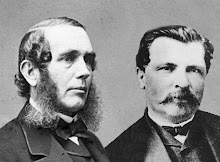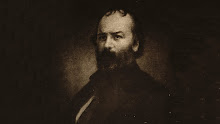What a joy to stand in a theatre you've loved since college, to look out into the audience and spot family and friends, to share your work with an engaged, enthusiastic local audience! What an absolute thrill was January 12 at the Academy of Music in Northampton. And what a turnout! I'm told some 350 showed up for WGBY's screening of Episode 1 of the 3-part series Currier & Ives: Perspectives on America, which will air on Channel 57 throughout western New England on February 25 at 9pm. As someone who grew up in this area but who was been away from the region for about 20 years, the day was the ultimate homecoming. Plus I got to say "Hi, Mom!" to Mrs. Dorothy Steele.
The Academy screening was the largest of three screenings that took place over the weekend. On Sunday, a private event was held at the Springfield Museums to celebrate supporters of WGBY and the Springfield Museums. Part 1 was screened here, as well, and Chris Lane of the Philadelphia Print Shop and PBS' 'Antiques Road Show' gave a fabulously informative presentation with even more background on The Printmakers to the People. Lane is a wonderful speaker and renders complicated concepts entirely digestible. On Friday, a couple of dozen folks braved a pea-soup fog and nasty rain to join us for an intimate screening at Hancock Shaker Village in Hancock, Massachusetts. The small size of the group helped make it feel like a gathering of friends enjoying a lively conversation after the screening - great fun! Again, I enjoyed the engaged, inquisitive, and enthusiastic audience.
The response to the show hints to me that our timing is good -- that New Englanders, and probably all Americans, are interested in learning more about this subject at this time. Why is that important? Because without reminders like this programming, interest inevitably will wane and these images may cease to resonate with younger generations. Their relevance will lessen. I care less that dollar values will drop than I care about the priceless history that will be lost.
This entry must be short because the editing continues! We are working on Part 2, which is shaping up to have a slower pace than Part 1, a nice change. The first episode was rather quickly paced out of necessity because it serves as an overview and is extremely comprehensive. In Episode 2, we honor the artists behind the iconic images and follow the passion of Currier & Ives collectors like John Zak and Sid Alpert, both instrumental to the success of this educational partnerhip. Both men are also victims of the "magnificent obsession" of collecting, as an audience member called it over the weekend!
I'll keep you posted. Thanks to the Academy of Music and everyone who attended the screenings!!
Friday, January 18, 2008
Thursday, January 3, 2008
Part One is Done. Almost.
Editing, recording narration, hosting concerts, giving speeches, and enjoying the holidays: it has been one busy month! A rough cut of Part 1 was completed before Christmas and after a little spit 'n polish next week, it will be ready for its screening at Northampton's Academy of Music on January 12, 2008 at 3pm. Part 1 is called "Printmakers to the People" and focuses on Currier & Ives' early years, turning points for the firm and personal insights into the fascinating business partners.
We learned a few things about time management from editing the short because creating movement on these static images takes a big chunk of editing time. You can 'move the eye' around the screen and create a dynamic composition without special moves by going closer into the images and revealing the details that aren't apparent at first glance. These details - dress, machinery, interaction, etc. are the magic of Currier & Ives. Once you start zooming in on them, it is impossible to view the prints the same way. The images provide a more vibrant, dynamic history lesson than any textbook.
Believe it or not, some shooting is still underway! Today, the crew videotaped re-enactments at Old Sturbridge Village, with two staffers acting as Mr. Currier & Mr. Ives working together in a business setting. These will be used minimally, but they will help fill out 3 half-hours largely reliant upon only 7 images of the men, and only 2 of Ives! It was a frigid but beautiful, wintry day and cameraman Mark Langevin captured some stunning winter-in-New-England images that will remind you of...you guessed it: a picture print by Currier & Ives!
Next week, we will see how teachers are using the collection in their actual lesson plans, when we visit a classroom at the High School of Commerce in Springfield, Massachusetts. One teacher is looking at women and styles of dress in Currier & Ives prints to spark a discussion about clothing in relation to health and gender roles. Should be interesting! This is the partnership at work: expanding the impact of the collection among students and beyond.
I've enjoyed several speaking engagements over the past month and it seems I never run out of things to talk about! Some crowds are more interested in the history, others in the art, others in the business side of the New York City firm. Today I got a question that stumped me: where was the lithographic paper made? Any takers? I'm looking into it.
The Currier & Ives Holiday Pops concert last month was just a joy from beginning to end. The audience was able to view the short video before entering the concert and so they sat down a little more informed about what they were about to see. Wintry and holiday images and details of prints were shown on a large screen as the chorus sang and the Springfield Symphony Orchestra worked its magic. I attended both weekend performances in order to hand out literature and answer questions about the upcoming series and it was just as good the second time around!
Scott Simon recorded his narration by phone from Washington, D.C. because that worked out better for all parties involved. His voice, as I suspected, is just perfect for the project and it vastly enhances the docs.
I'll keep you posted.
We learned a few things about time management from editing the short because creating movement on these static images takes a big chunk of editing time. You can 'move the eye' around the screen and create a dynamic composition without special moves by going closer into the images and revealing the details that aren't apparent at first glance. These details - dress, machinery, interaction, etc. are the magic of Currier & Ives. Once you start zooming in on them, it is impossible to view the prints the same way. The images provide a more vibrant, dynamic history lesson than any textbook.
Believe it or not, some shooting is still underway! Today, the crew videotaped re-enactments at Old Sturbridge Village, with two staffers acting as Mr. Currier & Mr. Ives working together in a business setting. These will be used minimally, but they will help fill out 3 half-hours largely reliant upon only 7 images of the men, and only 2 of Ives! It was a frigid but beautiful, wintry day and cameraman Mark Langevin captured some stunning winter-in-New-England images that will remind you of...you guessed it: a picture print by Currier & Ives!
Next week, we will see how teachers are using the collection in their actual lesson plans, when we visit a classroom at the High School of Commerce in Springfield, Massachusetts. One teacher is looking at women and styles of dress in Currier & Ives prints to spark a discussion about clothing in relation to health and gender roles. Should be interesting! This is the partnership at work: expanding the impact of the collection among students and beyond.
I've enjoyed several speaking engagements over the past month and it seems I never run out of things to talk about! Some crowds are more interested in the history, others in the art, others in the business side of the New York City firm. Today I got a question that stumped me: where was the lithographic paper made? Any takers? I'm looking into it.
The Currier & Ives Holiday Pops concert last month was just a joy from beginning to end. The audience was able to view the short video before entering the concert and so they sat down a little more informed about what they were about to see. Wintry and holiday images and details of prints were shown on a large screen as the chorus sang and the Springfield Symphony Orchestra worked its magic. I attended both weekend performances in order to hand out literature and answer questions about the upcoming series and it was just as good the second time around!
Scott Simon recorded his narration by phone from Washington, D.C. because that worked out better for all parties involved. His voice, as I suspected, is just perfect for the project and it vastly enhances the docs.
I'll keep you posted.
Subscribe to:
Posts (Atom)

















